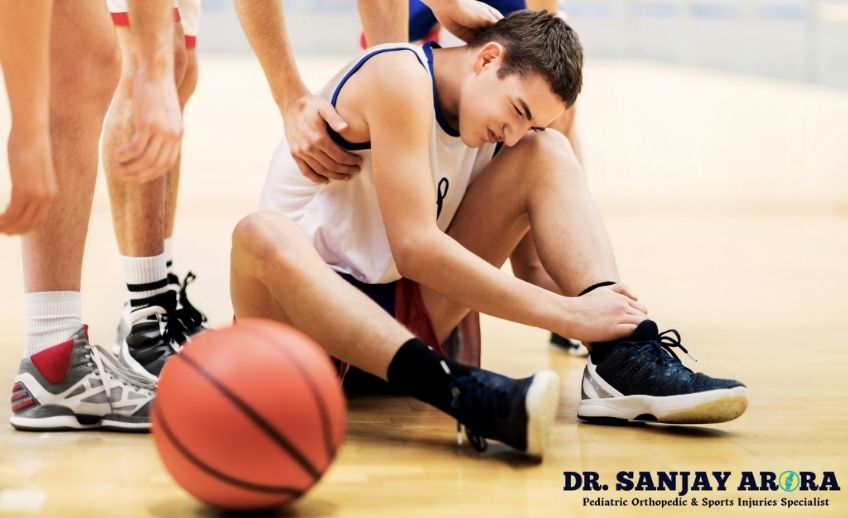SPORTS INJURIES

Sports injuries refer to the kinds of injuries that occur during sports or exercise. While it is possible to injure any part of the body when playing sports, the term sports injuries are commonly used to refer to injuries of the musculoskeletal system.
Book an Appointment

Some of the most common sports injuries include:
- Sprains — Tears to the ligaments that join the ends of bones together. The ankles, knees, and wrists are commonly affected by sprains.
- Strains — Pulls or tears of muscles or tendons (the tissues that attach the muscles to the bones).
- “Shin splints”—pain along the outside front of the lower leg, commonly seen in runners.
- Achilles tendonitis or rupture of the Achilles tendon—These injuries involve the large band of tissue that connects the calf muscles to the heel.
- Fractures of the bones.
- Dislocation of joints
Acute injuries usually occur suddenly while participating in sports or exercise. They may result in sudden and severe pain, the inability to bear weight on a limb, or the inability to move the affected part of the body. Chronic injuries usually result from overuse of one area of the body over a period of time. Symptoms of chronic injuries include soreness, dull aching pain, and pain during participation in physical activity.
What happens to the tissues after an acute injury?
When a runner “pulls a groin” or a tennis player “strains a tendon,” the soft tissues in the area of pain are injured. Immediately after the injury, there are disrupted fibers of the affected muscle, tendon, and/or ligament. Additionally, the tiny blood vessels (capillaries) that normally supply blood and oxygen to these tissues are broken. The broken capillaries then leak varying amounts of blood and serum into the adjacent tissues. Therefore, soon after a soft tissue injury, localized swelling occurs. The injured tissues become painful and tender, both directly from the trauma to them and indirectly from the subsequent swelling. This leads to the stiffness, pain, and tenderness that so often accompany the inflammation of tendinitis, bursitis, as well as strain and sprain injuries. It should also be noted that even a bone injury (such as a fracture) is typically accompanied by injury to the nearby soft tissues.
So, what is best applied after the injury?
In a word, ICE.
The swelling and much of the inflammation that follows an injury is largely due to the leakage of blood from the ruptured capillaries. Therefore, cold applications with ice can help by causing the blood vessels to constrict (clamp down). This constriction of the blood vessels prevents further leakage of blood and serum and minimizes swelling and pain. The cold from an ice pack application also has the added benefit of providing pain relief.
In fact, the optimal management of an acute injury can easily be remembered using the acronym,
- Rest (minimize movement of the injured body part).
- Ice (apply a cold pack).
- Compression (light pressure wrap to the affected body part can help minimize leakage of blood and swelling)
- Elevation (raise the body part up so that the pressure from the blood and tissue swelling the affected area is reduced as the fluids drain from the area by gravity)
The Benefits of Ice and Heat Therapy
Both heat and cold therapies have been used to help alleviate pain resulting from sports injuries, and both have their role in treatment and rehabilitation.
In general, application of cold packs or ice has the following effects:
- Reduces swelling following a traumatic injury.
- Reduces inflammation.
- Produces a numbing effect than can reduce pain.
- Decreases blood flow to an area.
- Decreases muscle spasms.
The effects of heat therapy include:
- Increased blood flow to an area.
- Relief from tension or tightness in muscles.
- May reduce joint stiffness.
- Optimizes healing/rehabilitation environment in tissues through influx of cells involved in tissue repair (as a result of increase in blood flow).
- Like cold therapy, heat therapy may provide pain relief.
- Increase in flexibility
Ice or cold packs are usually most effective on fresh injuries (within the first two to three days after a traumatic injury) since they reduce pain and swelling. Ice may also be required for flare-ups of chronic conditions. Cold or ice packs should be applied several times per day for up to 15 minutes at a time. If you’re using ice, never apply it directly to the skin. Ice packs should be covered with a towel or cloth before application.
Heat therapy, in contrast, is most often recommended for chronic, long-term ailments, including muscle tightness and tension. Muscle aches are one type of complaint that often improves with heat therapy. Like cold packs, heat therapy should be applied for no longer than 15 minutes at a time and may be used several times per day. After four or five days following a traumatic injury, heat therapy may help the healing process. Heat therapy may be administered by using moist warm towels, microwaveable heating packs or bean bags, or electric heating pads. If you’re using an electric heating pad, take extra care that you do not fall asleep on the pad, since this can lead to serious injury.






